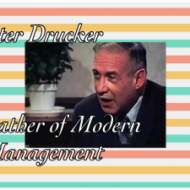Posted by Managementguru in Marketing, SEO, Social Media
on Jan 7th, 2017 | 0 comments

Why Inbound Marketing is Crucial to B2B Success Business consumers continue to reject traditional marketing strategies, while they are more interested in collecting info and learning about products before they buy without all the pressure of a regular sales pitch. Pic Courtesy : Hubspot Kindling the interest is the best bet to reach a customer and begin building a relationship that will be rewarding down the line. The important thing is that inbound marketing makes it apparent that you care about their needs and want to guide them through the decision-making process. Click this link to view and save popular Infographics on Inbound Marketing. Things You Didn’t Know About Inbound Marketing As we have moved into another fresh year, it is the right time to consider your inbound marketing efforts. What is Inbound Marketing? It is a marketing technique that focuses on helping your customers find you rather than going out to get your audiences’ attention. It is not about shouting out loud and propagating your product/ service’s unique selling propositions. It is about providing value to your customers – something that gives them information or is beneficial to them. It is about looking at various avenues for content marketing and driving traffic to your site. It is about channelizing blogs, podcasts, eBooks, videos, ezines, SEO, Social Media Marketing and all other types of content to invite your customer. Content marketing is the trend and doing it right is essential and not a choice. Read this blog post on B2B Marketing Strategies that will help small business owners to capture the millenial market through content-driven lead generation. http://triple20.com/b2b-marketing-strategies/ Creating Content that brings Huge Traffic + ROI Break down your content marketing strategy Pretty much any good content marketing strategy has some combo of these goals: Raise brand awareness Generate more search traffic (target specific keywords) Improve search rankings (get backlinks) Drive email subscriptions / generate leads That’s how you should approach content marketing. Focus on three or four main types of content: Social-viral content (drives traffic, builds awareness) Evergreen content (keyword-focused, performs well in search) Link-earning content (generates links from other sites and publishers) Lead-gen content (upgrades or downloadable pieces in exchange for email address) Each piece you publish should help you PULL OFF at least one of your goals, but it doesn’t have to accomplish all of them. Pic Courtesy: Inbound Marketing Landscape Capturing search traffic Evergreen content is purpose-built for search. It’s there to GIVE answers to search queries or give guidance on particular topics that are often searched by a target market. Today’s Investment, Tomorrow’s Profit The investments you make today in THE FORM of helpful resources for your customers through blogs, email content more actually turn into long term profits. The information you have compiled will continue to be searchable for all clients in the future and will continue to earn returns on a consistent basis. When done right, your web presence can be your single best salesman. What’s the Difference between Content Marketing and Inbound Marketing? Both types of marketing occur online. Both CONCENTRATE on building lasting relationships with leads, prospects, and customers. And they’re both focused on the creation of valuable content that educates and entertains audiences. Content marketing can improve brand awareness and visibility, generate leads, nurture leads, and ultimately convert them into customers who are ready to buy, and want to buy from your brand. Though inbound does rely heavily on content and it wouldn’t exist without it: it also includes other activities like, Marketing automation, Technical SEO, Product or service trials, Website design, and interactive tools all of which may fall outside of the scope...

Posted by Managementguru in How To, Marketing, Social Media
on Oct 8th, 2015 | 0 comments

As Halloween the beloved festival observed in many countries is fast approaching, the retail market is like steaming hot. Manufacturers and Marketers are on a constant roll to maximize the sales volume with a decent margin. Christmas follows suit and the market enthusiasm is never going to boil down. People will be on a “Shopping Spree” and will definitely not mind spending a few extra bucks on their purchases. So, how the retail market which is going to be the shopping hub react to this “Mega Holiday Shopping?” Holiday #ecommerce sales are important for many online retailers In some cases, small business owners might see a significant portion of total annual sales in just a couple of months. Understanding what to expect in terms of growth or trends may help with planning your holiday season. The holiday shopping season will start long before #Black Friday or #Cyber Monday. In fact, at least 25 percent of holiday shoppers in the United States will purchase a Christmas gift before Halloween. Year after year, online retail sales outpace retail sales overall, and 2015 will be no exception. But regardless of where a product is sold, it will be a good year for retail. 4 Predictions for the 2015 Holiday Shopping Season Early shopping, Ecommerce Sales Growth, Improved #email marketing, and #mobile commerce will be among the most important ecommerce trends during the 2015 Christmas shopping season, which lasts from the end of October through December 24. Two things will make email even better this holiday season First, expect to see more companies automate email messages, so that when shoppers make a holiday purchase they will see follow up messages that are designed to make additional sales and retain those holiday customers all year long. Second, email marketers are getting better at segmentation and personalization, which, in turn, should make an already effective #marketing vehicle even better. Three factors will continue to push growth for mobile ecommerce First, even more sites are responsive and mobile optimized. Having a responsive website is not a competitive advantage in 2015; it is a competitive requirement. Second, as smartphone screens get larger, mobile ecommerce becomes easier. The Samsung Galaxy S6 is 5.65 inches tall and 2.78 inches wide. The iPhone 6 Plus is 6.22 inches tall and 3.06 inches wide with a 5.5 inch HD display. On devices like these, it is simply easier to shop. Third, mobile payment options are improving, again making it easier to shop from a smartphone. Curated from 4 Predictions for 2015 Holiday Shopping Season | Practical Ecommerce How to prep your ecommerce store for holiday shoppers Even though it’s only early October, if you’re online #retail business isn’t already gearing up for the holiday season, you may miss out on revenue. So what should you and your staff be doing now to ensure your ecommerce store is able to handle the extra holiday-related traffic? Don’t make any drastic changes to navigation or layout right now Make certain your site can handle the additional holiday traffic Ensure your site is up to speed Show that your site is secure Ensure you’re properly stocked – and can re-order inventory quickly if necessary Staff up Make sure people can shop from a variety of devices Optimize images and give your site a festive feel Showcase top-rated items – and offer gift suggestions Alert customers to holiday shipping deadlines Offer live chat Add a gift-wrap option Offer free shipping Provide hassle free exchanges/returns Make checking out easy Provide a self-service option so customers can check on shipping and get answers to FAQs Curated from How to prep your ecommerce store for holiday shoppers | CIO Ultimately the customers must leave...

Posted by Managementguru in Motivation, Quotes and Quotes Only
on Feb 7th, 2015 | 0 comments

Top 50 Quotes from Peter Drucker Peter Drucker is known as the father of modern management. A prolific writer, business consultant and lecturer, he introduced (rather re-invented) many management concepts that have been embraced by corporates all over the world. TOP 50 MARKETING AND SALES QUOTES This modern “Managementguru” has delivered timeless and time-tested ideas on management, leadership, change, education, motivation, marketing and what-not. A lot of companies are successfully functioning based on Peter Drucker’s management concepts. What follows is a compilation of Peter Drucker’s sayings and messages to the management fraternity. His open and result-driven thought process is what attracts me the most. “Doing the right thing is more important than doing the thing right.” “If you want something new, you have to stop doing something old.” “There is nothing quite so useless as doing with great efficiency something that should not be done at all.” “What gets measured gets improved.” “Results are gained by exploiting opportunities, not by solving problems.” “So much of what we call management consists of making it difficult for people to work.” “People who don’t take risks generally make about two big mistakes a year. People who do take risks generally make about two big mistakes a year.” “Meetings are by definition a concession to a deficient organization. For one either meets or one works. One cannot do both at the same time.” “Long-range planning does not deal with the future decisions, but with the future of present decisions.” “Management is doing things right. Leadership is doing the right things” “The best way to predict your future is to create it” “The most important thing in communication is to hear what isn’t being said.” “Unless commitment is made, there are only promises and hopes; but no plans.” “No one learns as much about a subject as one who is forced to teach it.” “Efficiency is doing the thing right. Effectiveness is doing the right thing.” “Whenever you see a successful business, someone once made a courageous decision.” “The leaders who work most effectively, it seems to me, never say “I.” And that’s not because they have trained themselves not to say “I.” They don’t think “I.” They think “we”; they think “team.” They understand their job to be to make the team function. They accept responsibility and don’t sidestep it, but “we” gets the credit. This is what creates trust, what enables you to get the task done.” “The purpose of business is to create and keep a customer.” “Business has only two functions — marketing and innovation.” “Your first and foremost job as a leader is to take charge of your own energy and then help to orchestrate the energy of those around you. “Plans are only good intentions unless they immediately degenerate into hard work.” “Innovation is the specific instrument of entrepreneurship…the act that endows resources with a new capacity to create wealth.” “Trying to predict the future is like trying to drive down a country road at night with no lights while looking out the back window. “ “A manager is responsible for the application and performance of knowledge. “ “Strategy is a commodity, execution is an art.” “The aim of marketing is to know and understand the customer so well, the product or service fits him and sells itself.” “A person can perform only from strength. One cannot build performance on weakness, let alone on something one cannot do at all.” “Management by objective works – if you know the objectives. Ninety percent of the time you don’t. “Most discussions of decision making assume that only senior executives make decisions or that only senior executives’ decisions matter. This is a...

Posted by Managementguru in Business Management, Decision Making, Human Resource, Organisational behaviour, Principles of Management
on Apr 19th, 2014 | 0 comments

Business Policies – Framing and Execution Business policies are the keystone in the arch of management and the life-blood for the successful functioning of business, because without well-laid down policies, there cannot be lasting improvements in the economic condition of the firm and labor-management relations. A policy is a positive declaration and a command to its followers. It translates the goals of an organization into selected routes and provides the general guidelines that prescribe and proscribe programmes, which in turn, dictate practices and procedure. Attainment of Objectives: Buisness policies are general statement of principles for the attainment of objectives which serve as a guide to action for the executives at different levels of management. They pave a broad way in which the sub-ordinates tread along towards accomplishing their objectives. Hierarchy: For each set of objectives at each level, there is a corresponding set of policies. The Board of Directors determine the basic overall corporate policiesThe top management decides on the executive corporate policiesManagers decide on the departments / divisional policiesMiddle managers handle the sectional policies Consistent Decisions contributing to the Objectives: The policies delimit the area within which a decision has to be made; however, they do allow some discretion on the part of the man on the firing line, otherwise, they would be mere rules. At the same time too much of discretion in policy matters may prove harmful to the accomplishment of organizational objectives and hence it is generally within limits. Mutual Application: Policies in general are meant for mutual application by sub ordinates. They are fabricated to suit a specific situation in which they are applied, for they cannot apply themselves. Unified Structure: Policies tend to predefine issues, avoid repeated analysis and give a unified structure to other types of plans, thus permitting managers to delegate authority while maintaining control. Policies for all Functional Areas: In a well-structured and managed organization, policies are framed for all functional levels of management. Corporate planningMarketingResearch and DevelopmentEngineeringManufacturingInventoryPurchasePhysical DistributionAccountingFinanceCostingAdvertisingPersonal SellingSpecial Promotion, are some areas that require clear-cut policies. Clear-Cut Guidelines: Policies serve an extremely useful purpose in that they avoid confusion and provide clear-cut guidelines. This enables the business to be carried on smoothly and often without break. They lead to better and maximum utilization of resources, human, financial and physical, by adhering to actions for...

Posted by Managementguru in Interview Questions, Resume Samples
on Apr 6th, 2014 | 0 comments

Resume for Sales Know the purpose of your resume Need help in creating or updating your resume? It certainly can be a tough task because your resume is going to be reviewed by software as well as by hiring managers. This new column brings you top resume tips for choosing a resume format, selecting a resume font, customizing your resume, using resume keywords, explaining employment gaps, and more tips for writing interview winning resumes. Try to understand that the purpose of building your resume is to land an interview and make it as precise as possible and impress the recruiters with your profile. Business and Marketing Writing A great resume is one that highlights your strengths and emphasizes the highs of your career. It is imperative for every professional to get his resume periodically updated to move up the corporate ladder. A resume has four sections: Personal Information. This includes your full name, city, contact number, e-mail address and social media profiles. Your personal information can appear at the top center part of the resume with a header positioned below it. Employment History. Your work history must be arranged beginning from current or most recent employer. It must indicate your designation, inclusive dates of employment and a description of your scope of responsibilities. Educational Attainment. This should also be arranged according to highest level of education attained. Details should include degree earned, inclusive dates and relevant awards or achievements. You do not have to include information from secondary education and earlier. Special Skills. This section is where you highlight core competencies and other skills you have that are relevant to the job opening. What are the key ingredients of a great resume? A sparkling profile with sufficient emphasis on your key strengths. A cover letter that guarantees a personal interview. Customized and tailor-made resumes. Designed by skilled resume writing experts. Professional formatting and layout. What should be there in a profile statement? Understand that highlighting your skills and experience in your profile is the “Catch Point” to impress your new recruiters. Financial Planning and Strategy, Marketing Concepts, Positioning, People Management, Territory Management, Sales Planning, Competitive Analysis, Understanding the Customer, Product Development, Client Relationships, Creative Services are some of the criteria that make a marketing/sales manager stand out from the crowd. Try to bring out the achievements in your career till date and who might be the better master to do it other than yourself! Q: What’s the most common resume mistake? A: Making too many general claims and using too much industry jargon that does not market the candidate. A resume is a marketing document designed to sell your skills and strengths rather than just portray a bio of the candidate. For unemployed candidates, handing out resumes should be a full-time job. The majority of mid- to senior-level positions are filled through networking, so contact absolutely everyone you know in addition to recruiters who are in a position to hire you or share...









